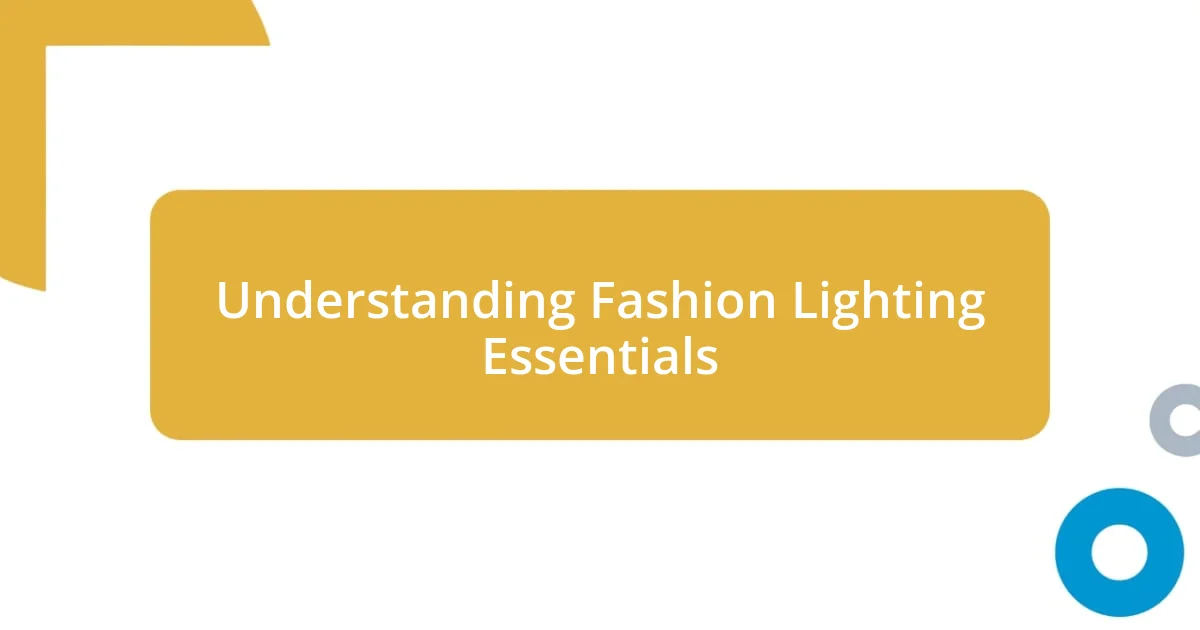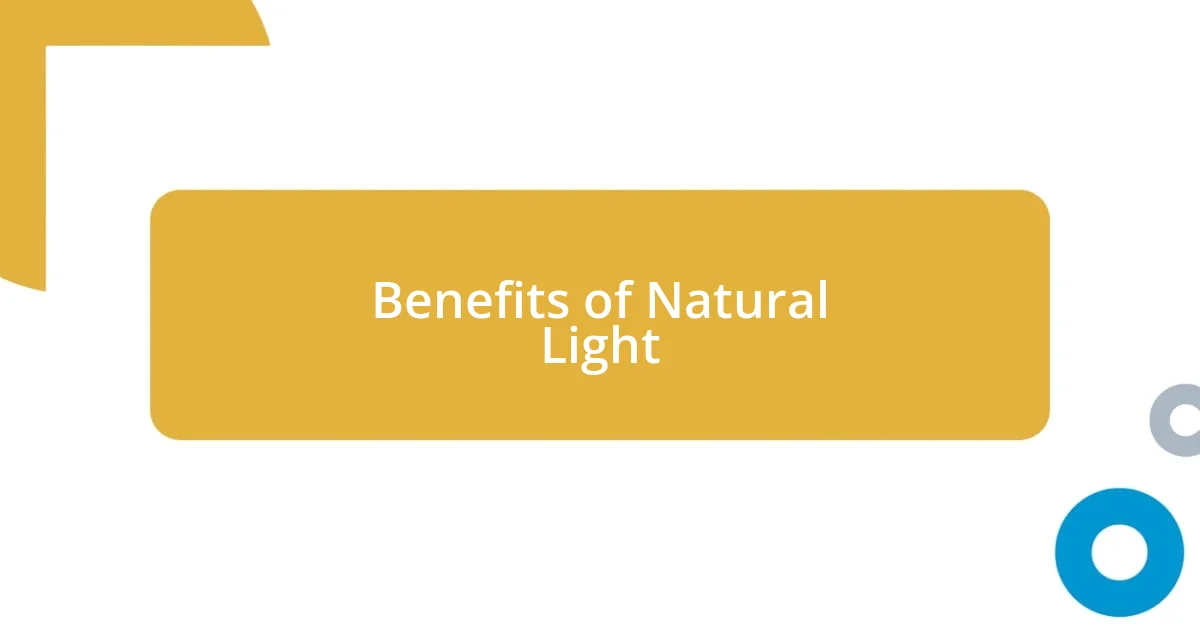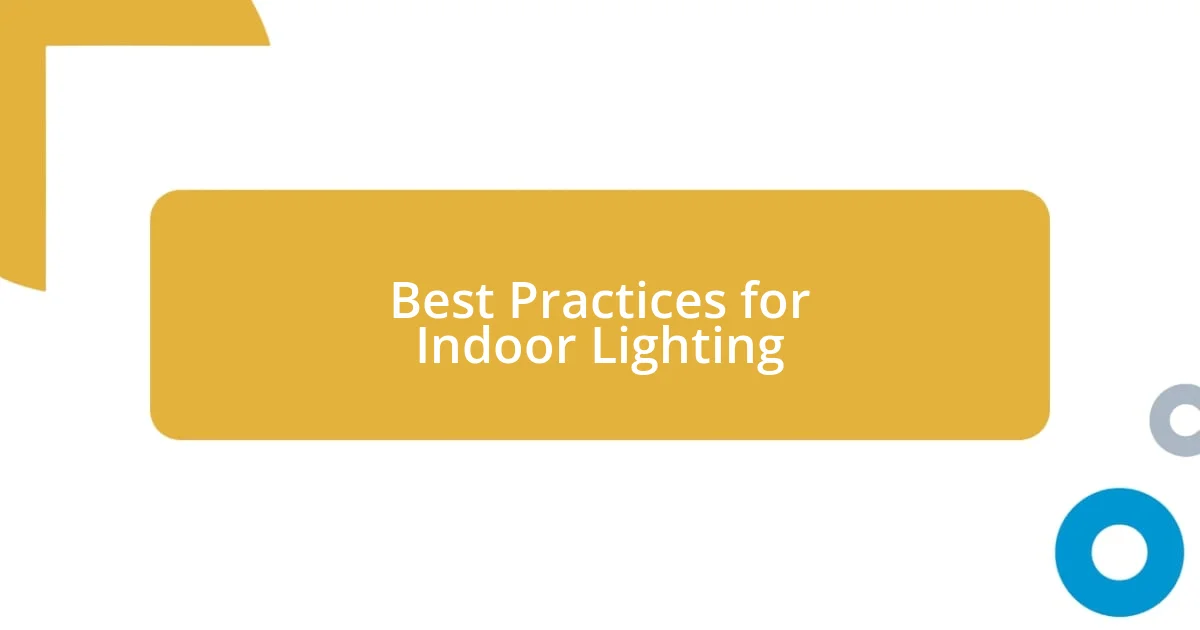Key takeaways:
- Understanding different types of lighting (ambient, directional, accent) is essential for enhancing the depth and detail in fashion photography.
- Utilizing natural light can create flattering tones and evoke emotions, making images feel vibrant and inviting.
- Effectively manipulating light angles, color temperatures, and shadows helps create depth and character in fashion photography, transforming ordinary shots into artful visuals.

Understanding Fashion Lighting Essentials
Lighting plays a pivotal role in fashion photography, influencing not just the mood but also how outfits are perceived. I remember the first time I shot a lookbook; I used harsh, direct light without realizing it washed out the colors. It was a tough lesson, but it made me appreciate how soft diffused lighting can beautifully showcase fabric textures and hues.
When considering light sources, think about the emotional undertones you want to evoke. Do you want a warm, inviting feel or something more dramatic and edgy? I often experiment with colored gels to add flair to my shoots, which can alter the entire vibe of a fashion piece. It’s fascinating how a simple change can lead to a completely different emotional response from the viewer.
Angle and direction of light can also dramatically shift the scene’s narrative. One time, I positioned my light low to create long shadows, and it transformed the model’s silhouette into something striking and bold. Isn’t it amazing how something as simple as changing a light’s angle can turn an ordinary shot into art?

Types of Lighting for Fashion
Lighting in fashion can be categorized into three primary types: ambient, directional, and accent lighting. Ambient lighting serves as the foundational light source in a setting, providing overall illumination. It’s what I rely on most when setting up for a shoot in a studio. On an occasion, I used softbox lighting to fill the space evenly, which not only made the model comfortable but also highlighted the details in the clothing beautifully.
Directional lighting, on the other hand, is crucial for creating depth and texture. I vividly recall a shoot where I angled a single spotlight to emphasize the contours of a dress. The resulting shadows added an exquisite layer of drama, making the fabric come alive! This type of lighting is particularly effective in showcasing intricate designs or unique textures.
Lastly, accent lighting is perfect for drawing attention to specific features or details in a fashion scene. For example, during a recent outdoor fashion campaign, I used colored gels with focused lights to highlight accessories. This gave the shot an edgy twist that made the entire composition pop. It’s a reminder of how thoughtfully applied light can elevate a fashion photograph from good to stunning.
| Type of Lighting | Description |
|---|---|
| Ambient Lighting | Soft, even light that fills the space |
| Directional Lighting | Light that creates depth and emphasizes outlines |
| Accent Lighting | Focused light that highlights specific details or features |

Benefits of Natural Light
Natural light holds a special place in my heart, especially when I’m crafting fashion images. There’s something inherently warm and flattering about it that often makes my shots look more vibrant and alive. I remember one breezy afternoon when I decided to shoot outside during the golden hour—the quality of light enveloped the model, enhancing the colors of her outfit in a way artificial lighting could never replicate. That experience solidified my belief that natural light can imbue images with a sincere, inviting feel that’s simply unmatched.
Here are some benefits of using natural light in fashion photography:
- Flattering Tones: It enhances skin tones and fabric colors without the harshness of artificial lights.
- Dynamic Shadows: Natural light offers a variety of shadow patterns depending on the time of day, adding depth to images.
- Versatility: It can be easily manipulated with reflectors or diffusers to create different effects.
- Mood and Emotion: The warmth of sunlight can evoke feelings of comfort and happiness, resonating with viewers.
- Simplicity: It often requires less setup and equipment, allowing for more spontaneity and creativity during shoots.
Every time I shoot outdoors, I’m reminded of these advantages. The spontaneity of embracing the natural environment adds this invigorating element to my work.

Best Practices for Indoor Lighting
When it comes to indoor lighting, one of my best practices is to layer light sources. I often combine ambient, directional, and accent lighting to create a balanced atmosphere. For instance, in a recent indoor fashion shoot, I used overhead fixtures for general light, paired with floor lamps for warmth, and then added a touch of glamour with string lights that danced softly in the background. The transformation was magical! Have you ever noticed how a well-lit space can change your mood?
Another essential tip is to pay close attention to the color temperature of your lights. Warmer tones can create a cozy, inviting environment, while cooler tones often lend a more modern, sleek vibe. During one indoor photo session, I switched to a warmer light late in the day, and it instantly made the setting feel more intimate, almost like capturing a cherished moment with friends at home. This shift made me realize how crucial it is to think about the feelings we want to evoke through lighting.
Finally, I can’t stress enough the importance of avoiding harsh shadows and overly bright spots. Diffusers can work wonders in softening the light and providing a flattering effect. I remember struggling with directly overhead lighting that cast unflattering shadows on a model’s face. Adding a sheer fabric as a diffuser transformed the scene completely. Have you ever faced moments where simple adjustments made a world of difference?

Using Color Temperature Effectively
Using the right color temperature is a game-changer in fashion lighting. I recall a project where I experimented with different light bulbs, discovering that a soft, warm light brought out the beauty in textured fabrics perfectly. Each shot felt inviting, almost like wrapping the viewer in a cozy blanket—have you ever experienced that comforting glow that just makes everything feel right?
Conversely, I learned that cooler tones can create striking, dramatic looks. I once shot a collection that featured sleek, modern designs, and by using bluer light, I transformed the whole atmosphere. The images reflected a high-fashion edge that resonated with the designs and the concept we aimed for. It was mesmerizing to see how different light colors could evoke such contrasting feelings in the final images.
I often remind myself that the mood conveyed through color temperature can significantly impact the narrative of a shoot. A few weeks ago, I used a stark, bright light for a fashion campaign focused on minimalism; the result was sharp and clean, making the models look bold and confident. The lighting wasn’t just a backdrop; it became a character in the story we were telling. How frequently do we stop to consider the stories our lights tell?

Creating Depth with Lighting
Creating depth in a space through lighting is something I’ve always found fascinating. I like to think of lighting as an artist’s brush, adding layers and nuance to a scene. Recently, while working on a project showcasing fall fashion, I placed warm spotlights at varying heights. This not only highlighted the vibrant shades of the garments but also added a three-dimensional feel that pulled the viewer into the frames. Have you ever noticed how certain lighting can literally draw you into a photograph?
Another approach I’ve embraced is using backlighting to create silhouettes that pop. During an outdoor shoot, I positioned a light behind the model as the sun began to set. The result was a stunning halo effect, which added drama and depth, making the image incredibly striking. It was an absolute game-changer that elevated the visuals, reminding me that sometimes, it’s about playing with contrasts. Do you think backlighting could add a unique perspective to your own photographic endeavors?
I’ve also experimented with colored gels, which transformed standard lighting into something magical. At a recent gallery event, I used purple and blue gels to cast playful shadows across floors and walls, giving the space an ethereal ambiance. It invited guests to wander, intrigued by how the colors danced together, making the environment feel dynamic and alive. What emotions do you want to evoke when people step into your space? Leveraging lighting can play a pivotal role in curating those experiences!

Tips for Flattering Fashion Photography
When it comes to flattering fashion photography, angle and positioning can make all the difference. I remember a shoot where I encouraged models to be playful with their poses, allowing natural light to hit their faces at flattering angles. The result? Their smiles and personalities shone through, creating an authentic connection with the camera that I truly cherished. Have you ever felt that capturing joy in a single frame can be transformative?
Another gem I’ve learned is the power of soft diffused light. During one particular session, I used a sheer curtain to soften the harsh sunlight pouring into the studio. This subtle change instantly warmed the atmosphere and enveloped the models in a gentle glow, making the textures of their outfits pop effortlessly. Have you noticed how a simple piece of fabric can elevate the entire mood of your photos?
Lastly, never underestimate the impact of shadows. In a recent editorial shoot, I strategically used shadows to create dramatic contrasts that told a compelling story about the garments. The interplay between light and dark added intrigue, drawing the viewer’s eyes through the image in unexpected ways. It made me wonder: how do you play with shadows to enhance your narrative in photography?














